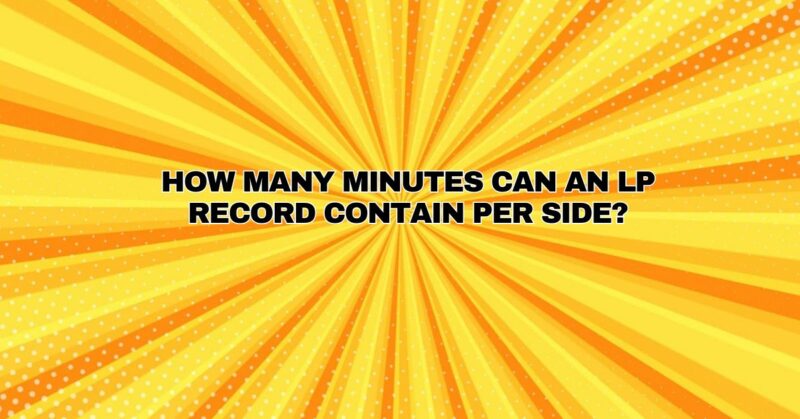Long Play (LP) records, commonly referred to as vinyl albums, have been a cherished medium for music playback since their introduction in the 1940s. One of the defining characteristics of LP records is their capacity to store music on both sides, offering listeners a unique and immersive listening experience. However, the duration of music that an LP record can contain per side is limited by factors such as the record’s size, rotational speed, and groove spacing. In this comprehensive article, we will explore the factors that influence the playing time of an LP record and provide insights into how many minutes of music can be accommodated on each side.
Key Factors Influencing LP Record Playing Time
- Record Size:
- LP records are typically 12 inches (30 cm) in diameter. This standard size provides more surface area for grooves, allowing for longer playing times per side compared to smaller vinyl formats like 7-inch singles.
- Rotational Speed:
- LP records are commonly played at two standard rotational speeds: 33 1/3 RPM (revolutions per minute) and 45 RPM. The choice of speed affects the playing time per side significantly.
- 33 1/3 RPM: This is the standard speed for most LP records. It allows for a longer playing time per side, as the record completes one full rotation approximately every 1.8 seconds.
- 45 RPM: This speed is typically used for shorter recordings, such as singles or EPs. At 45 RPM, the record completes one full rotation approximately every 1.33 seconds, resulting in a shorter playing time per side.
- Groove Spacing and Width:
- The physical grooves etched into the vinyl surface contain the audio information. The spacing and width of these grooves impact how much audio can be stored on a single side.
- Grooves with wider spacing and greater depth can accommodate more music but may result in a reduction in audio fidelity. Conversely, narrower grooves can yield higher fidelity but limit playing time.
- Recording and Mastering Techniques:
- Recording and mastering engineers play a crucial role in determining the optimal groove spacing and width to balance audio quality and playing time. Techniques such as dynamic range compression may be employed to maximize playing time while maintaining audio fidelity.
- Vinyl Thickness and Quality:
- The thickness and quality of the vinyl used for LP records can influence playing time. Thicker vinyl can potentially accommodate longer playing times but may require adjustments in groove spacing.
Playing Time of LP Records per Side
The playing time of an LP record per side can vary widely depending on the factors mentioned above. Here is a general guideline for playing time per side at the standard speeds of 33 1/3 RPM and 45 RPM:
- 33 1/3 RPM LP Record:
- On average, a 12-inch LP record played at 33 1/3 RPM can hold approximately 18 to 30 minutes of music per side.
- This range is typical for most full-length albums (LPs) and allows for extended listening experiences.
- 45 RPM LP Record:
- A 12-inch LP record played at 45 RPM is primarily used for shorter recordings, such as singles or EPs.
- At 45 RPM, a record can hold approximately 3 to 5 minutes of music per side.
- This speed is favored for hit songs, radio releases, and shorter compositions.
It’s important to note that these guidelines represent average playing times and can vary depending on the specific mastering choices made during the record’s production. Additionally, some audiophile and specialty LP records may have different groove configurations to optimize audio quality.
Conclusion
LP records, with their iconic 12-inch size and analog charm, offer a unique listening experience that combines musical enjoyment with tactile engagement. The playing time of an LP record per side is influenced by factors such as the record’s size, rotational speed, groove spacing, and mastering techniques.
Whether you’re savoring a full-length album on a 33 1/3 RPM LP or enjoying a concise single on a 45 RPM record, the vinyl format provides a tangible and immersive way to connect with music. LP records continue to captivate music enthusiasts and collectors with their timeless appeal and the artistry that goes into balancing audio fidelity and playing time.


